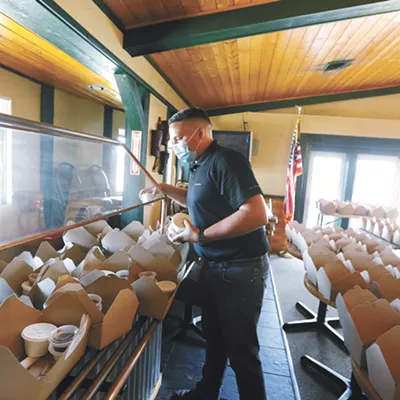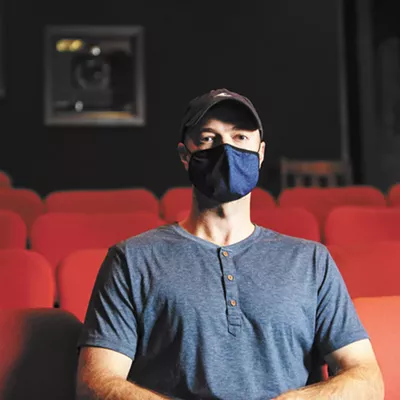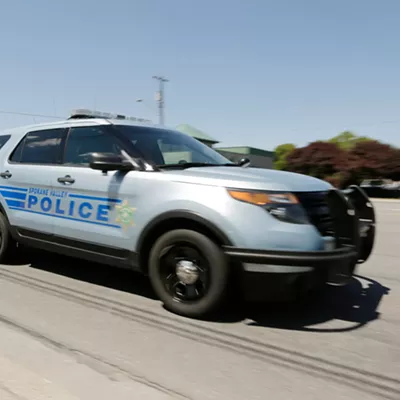
Four days ago, state epidemiologist Scott Lindquist felt confident that omicron, the new COVID-19 variant, had already made it to Washington. He just didn’t have any proof.
"I’m expecting a call any day from our genome sequencing folks to tell us, 'Hey, we see one,'" Lindquist told the Inlander on Friday.
That very night, workers at the University of Washington Virology Lab found three suspicious cases. Screening tests on the positive samples discovered what’s called an S-gene dropout, a mutation of the virus’s genome that is characteristic of omicron. The variant has concerned health experts due to its many mutations, some of which may make it more transmissible and possibly able to more easily evade vaccine or natural immunity.
Not wanting to make a mistake, the lab ran the screening test again, says Geoffrey Baird, the chair of Laboratory Medicine and Pathology at the UW Medicine Virology Laboratory. A genomic sequencing confirmed their suspicions: They had three cases of omicron in Washington.
Lindquist got the call he was expecting: Washington was the 13th state in the U.S. to find omicron, just over a week after news broke of the new variant spreading rapidly in South Africa. The three Washington cases were detected in people on the west side of the state.
"I'm amazed at how fast UW did this," Lindquist said at a press conference the next day.
The state health department says it does not yet know details about the three cases, besides that they involved a man in his thirties from Thurston County, a man in his twenties from Pierce County and a woman in her twenties from King County.
It’s too early to tell exactly how omicron will spread in the U.S., how much protection vaccines will offer, and whether the new variant causes a less severe disease than the delta variant, as early reports out of South Africa suggest.
But health officials in Washington insist that even if omicron evades immunity as some fear, we are better prepared now to battle it than we were the original virus in early 2020.
"Washington is ready for this," Lindquist says.
And that preparedness starts, he says, with being able to quickly detect where omicron is spreading.
Lindquist is quick to remind reporters that Washington was the first state to identify COVID-19 back in January of 2020. At the time, relatively few tests were available, and the virus was spreading unseen.
"Our surveillance system has always been very strong, and genotyping is just a portion of that. We’re able to get a good look at what’s going on in the state," Lindquist says.
Lindquist sees some similarities between Washington then and South Africa now. South Africa received backlash in the form of travel restrictions for identifying omicron first, even though it may have been spreading in other countries already. South Africa has also earned praise for finding omicron early among public health experts, much like Washington did in early 2020 for finding the original virus case in the United States.
Washington’s ability to identify variants is even stronger now, Lindquist says. The state sequences about 10 percent of all positive cases to determine the variant involved, ranking 6th among all states. For comparison, the U.S. as a whole sequences about 3.6 percent of samples, ranking 37th worldwide. South Africa sequences less than one percent. (Idaho also sequences around 10 percent of samples now, officials say.)
Sequencing more than 10 percent, Lindquist says, would not only be much more expensive, but it likely wouldn’t tell them much more than they already know. In other words, the "juice is just not going to be worth the squeeze," he says.
Already, the state makes sure to get representative samples from all parts of Washington. Labs that process COVID tests will send a portion of their samples to the state or another private lab that the state contracts with for sequencing to determine the variant.
Incyte Diagnostics, located in Spokane Valley, is one of the labs in Eastern Washington that sends samples in so that other labs can sequence for variants.
Carmen Wiley, clinical medical director at Incyte, says they process COVID tests to determine which samples are positive. Then lab workers randomly select from the positive samples and send them to the state for variant testing.
During the peak spread of COVID in September, Incyte sent two plates to the state per week, with each plate containing 94 positive samples, she says. Now, with case counts lower, they are sending one plate per week to the state for sequencing. Labs like Incyte don’t have approval to do their own variant testing, which is why COVID patients usually don’t know which variant they have. And when they send the samples to the state or another private lab for variant testing, they de-identify each sample so that it’s not trackable back to patients.
"The COVID variant testing that’s being done is not meant for medical purposes," Wiley says. "It's meant for public health and epidemiology."
That may at least partly explain why state officials don’t have more information on the three patients who tested positive for the omicron variant.
Still, once sequenced, the samples can still say a lot about how the virus that's caused this pandemic spreads and mutates. The genome sequencing of the virus samples is sort of like looking at the contents of a book, explains Baird, from UW Virology.
"We read a bunch of sentences and paragraphs from the book, and we place them back together to read the whole book," Baird says.
Not only can they identify omicron, but they can see if there are additional mutations or differences between any two cases.
Wiley says it’s this kind of collaborative process, from a nasal swab at the clinic all the way to a genome sequencing across the state, that helps explain why Washington has had success tracking the virus.
"It’s the reason why Washington state has done well, because clinical laboratories, university laboratories and research laboratories came together to support patient medicine during this crisis," Wiley says.
Identifying a new variant early, however, doesn’t mean it’s easy to contain. At every turn, SARS-CoV-2, the virus that causes the COVID-19 illness, has been able to bypass public health experts to box the virus in.
And this time, while health officials say vaccines remain the best defense against omicron, the variant may have a better ability to evade protection from prior infection or vaccines.
Still, Lindquist points out that omicron is far from the first COVID-19 variant that has concerned health officials. Some have done real damage even without becoming a worst-case scenario. For example, the alpha variant, which emerged in the United Kingdom, contributed to a wave of infections in the spring.
But others, like the gamma variant that emerged in Brazil, only played a small role in increasing COVID-19 infections statewide.
"We’ve had a couple false starts with variants here. A lot of people were worried about gamma and really talking doom and gloom, and gamma never amounted to what the concern was," Lindquist says.
Of course, the variant that did live up to the concerns was delta. It was first detected in Washington in February. By June, it made up the vast majority of cases. Now it makes up almost 100 percent of cases sequenced in Washington, according to the state health department, and it caused a massive fifth wave that hit this fall.
"Delta is just so much better [than previous variants] at infecting people. It really just wiped out all competition," Lindquist says. "I'm really anxious to see, will omicron even be able to get a foothold in Washington state? Or is delta going to be more competitive?"
In fact, that's partly why Lindquist remains unsure about omicron causing another wave locally. It may not be able to dethrone delta, which is still spreading at high rates locally — higher than it was in South Africa when omicron took off, Lindquist says.
"About a third of the population in Washington is still vulnerable to an infection because they haven’t been vaccinated or infected before. So there’s still room for infection, and delta is filling that void right now," Lindquist says.





















